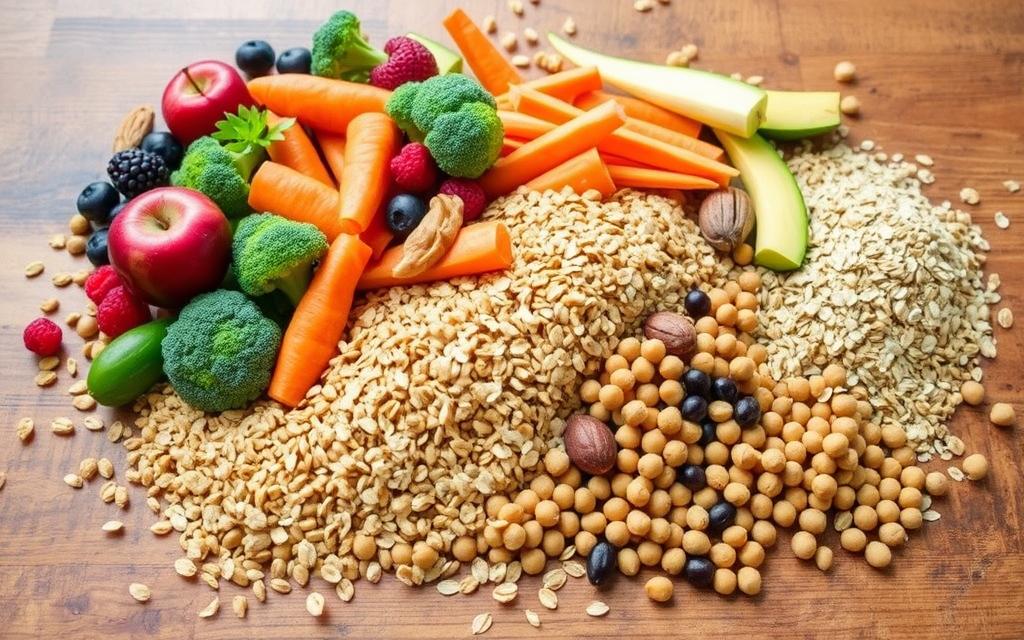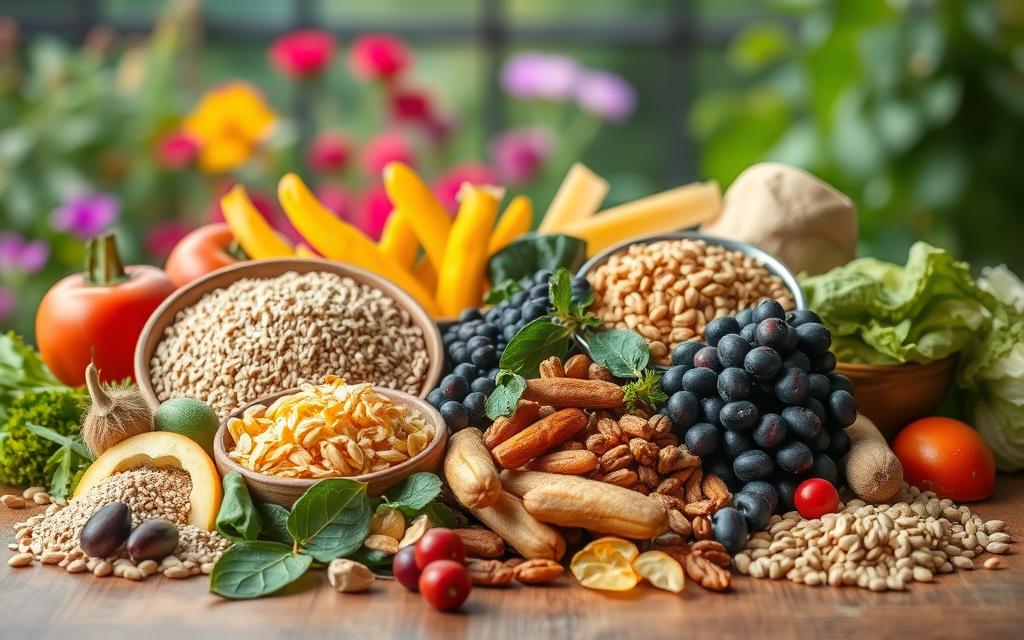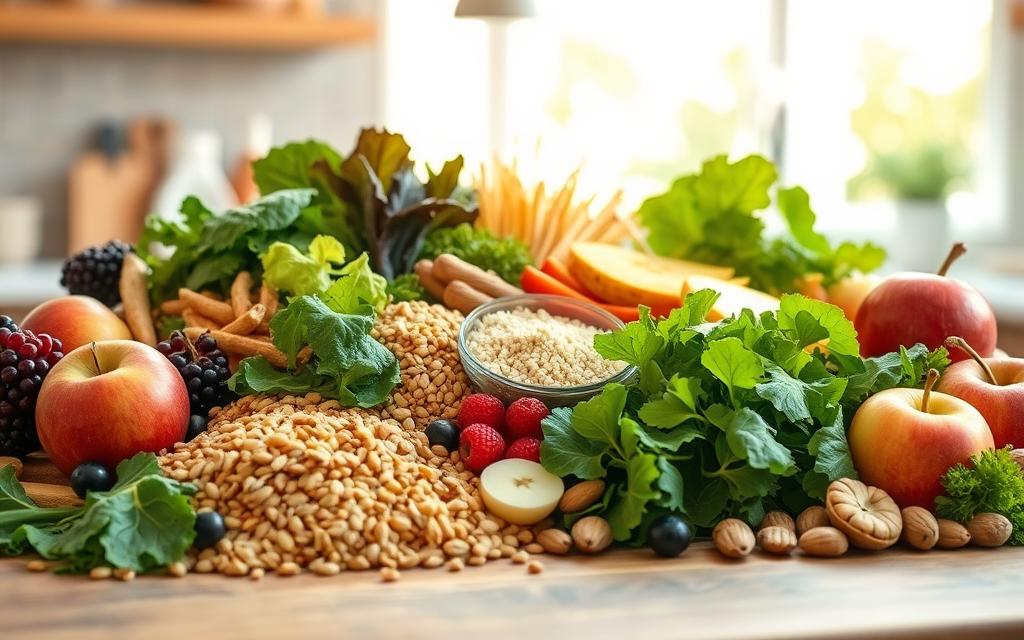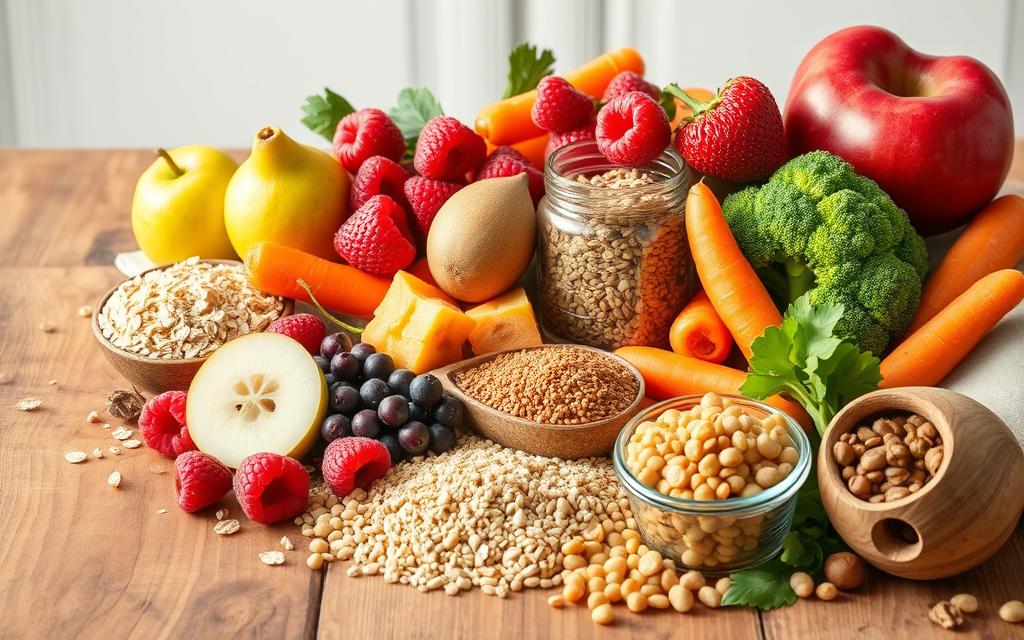Modern life often makes us overlook our health. We rush through meals, grabbing quick bites that don’t really nourish us. But, we might not realize how important our diet choices are, like the role of fiber.
Fiber is not just a number on food labels; it’s essential for our health. By adding more fiber-rich foods to our meals, we can change our health for the better. Small, mindful changes today can lead to a future filled with energy and longevity.
Let’s dive into the benefits of dietary fiber and find easy ways to eat more of it. Embracing fiber can improve digestion and make us happier.
Key Takeaways
- The role of fiber in your diet is crucial for maintaining good health.
- Our daily fiber intake directly affects digestion and overall wellness.
- Benefits of dietary fiber include improved gut health, heart health, and weight management.
- Increasing our fiber intake can prevent various diseases, including colorectal cancer.
- Incorporating high-fiber foods into our daily diet can be simple and rewarding.
- Understanding the different types of fiber aids in making informed food choices.
What is Dietary Fiber?
Dietary fiber is a type of carbohydrate found mainly in plants. It can’t be broken down by our digestive enzymes. This makes it move through our digestive system without being processed.
This unique property helps dietary fiber play a key role in our digestive health. Eating enough fiber helps keep our bowel movements regular. It also helps prevent constipation, which is important for our health.
The definition of dietary fiber highlights its importance in our diet. Experts say we should eat 30–35 grams of fiber a day if we’re men. Women should aim for 25–32 grams daily1.
But, many of us don’t get enough fiber. Only 5% of Americans meet these fiber intake goals2. In Europe, adults eat more fiber, showing a big difference from North America.
It’s important to close the fiber intake gap. People in the West need to eat 50% more fiber to meet health standards. Not getting enough fiber can lead to serious health problems, like heart disease and poor digestion.
Types of Dietary Fiber
Dietary fiber is divided into two main types: soluble and insoluble. Knowing about these types of dietary fiber helps us make better food choices. This supports our health goals.
Soluble Fiber
Soluble fiber turns into a gel when mixed with water. It has many soluble fiber benefits. It can lower bad LDL cholesterol, which reduces heart disease and type 2 diabetes risks.
Fruits, oats, and legumes are full of soluble fiber. They help keep our digestive system healthy.
Insoluble Fiber
Insoluble fiber doesn’t mix with water. It’s key for good bowel health. It makes stool bulkier and helps food move through our digestive system.
This helps prevent constipation and other bowel problems. Whole grains, nuts, and many vegetables are rich in insoluble fiber. They add a lot to our fiber intake.
| Type of Fiber | Sources | Health Benefits |
|---|---|---|
| Soluble Fiber | Oats, fruits (e.g., apples, pears), legumes | Lowers cholesterol, controls blood sugar |
| Insoluble Fiber | Whole grains, nuts, vegetables (e.g., carrots, broccoli) | Supports digestion, prevents constipation |

Only 5% of Americans meet the daily fiber goal of 30 grams3. Most people only get half of what they should. It’s crucial to eat both soluble and insoluble fiber to get all the benefits4.
The Role of Fiber in Your Diet
Fiber is key for good digestion and health. It helps move food through your body and prevents constipation. This is why fiber is so important for a healthy gut.
Eating foods high in fiber helps keep your weight in check and lowers disease risk. For example, only 5% of men and 9% of women get enough fiber, as advised by the National Academy of Medicine5.
Women under 50 should aim for 25 grams of fiber daily, while those over 51 should aim for 21 grams. Men under 50 need 38 grams, and those over 51 need 30 grams6. Fiber also helps lower bad cholesterol and control blood sugar, preventing sudden spikes.

It’s important to know that many foods now have added fiber, often without clear labels. Too much fiber from these foods can cause stomach problems like bloating and diarrhea. So, it’s best to limit fiber from processed foods to 10 grams per serving7.
Benefits of Dietary Fiber
Dietary fiber offers many benefits for our health. Adding enough fiber to our diet can improve our overall well-being.
Gut Health and Digestion
Dietary fiber is key for fiber and gut health. It helps us have regular bowel movements and prevents constipation. A diet rich in fiber can make our stool bigger and heavier, helping us go to the bathroom regularly. It also lowers the chance of getting hemorrhoids and diverticular disease8.
Fiber moves through our digestive system without being broken down. This helps our bowels work normally8. Soluble fiber also helps control how much sugar our body absorbs. This is good for people with diabetes8.
Heart Health
Fiber is good for our hearts. Eating enough fiber can lower our triglyceride and cholesterol levels. This might help prevent heart disease9.
Soluble fiber helps lower cholesterol and has been shown to reduce blood pressure and inflammation. This makes fiber a key part of a heart-healthy diet8.
Blood Sugar Regulation
Fiber helps control blood sugar, which is great for people with diabetes or prediabetes9. It moves slowly through our stomach, making us feel full longer. This helps with weight management9. Soluble fiber also helps keep blood sugar levels stable, which is important for diabetes management8.
Weight Management
Using fiber for weight management is a good idea. A diet high in fiber can make us feel full, leading to eating fewer calories and possibly losing weight8. Regular fiber intake helps us feel satisfied longer, controlling hunger and aiding in weight management9.
Disease Prevention
Lastly, fiber can lower the risk of diseases like colon cancer and heart disease9. The benefits of fiber depend on the type, amount, and individual differences. It’s important to choose the right fiber sources10.

How Much Fiber Do You Need?
Fiber is key for our health. The American Heart Association says we should eat 25 to 30 grams of fiber every day. Sadly, most adults in the U.S. only get about 15 grams, which is half of what we need11. Eating enough fiber can make us healthier and lower our risk of serious diseases.
Let’s look at how much fiber we should eat based on who we are:
| Group | Recommended Fiber Intake (grams) |
|---|---|
| Women under 50 | 25 to 28 |
| Men under 50 | 31 to 34 |
| Women 51 and older | 22 |
| Men 51 and older | 28 |
| Children 1 to 18 | 14 to 31 (depending on age and sex) |
To get enough fiber, we should eat a variety of high-fiber foods. For example, split peas have 16.4 grams of fiber per cup. Lentils have 15.6 grams per cup12. Half a cup of beans like kidney beans or garbanzos has about 7 to 8 grams of fiber11. We should also eat at least five servings of fruits and vegetables a day. Some fruits, like raspberries, have 8 grams of fiber per cup12.
It’s clear we can meet our daily fiber needs with the right food choices. Many of us don’t get enough fiber, but eating more can greatly improve our health13.

Fiber Recommendations for Different Age Groups
Fiber is key for our health, and it changes with age. Adults need different amounts of fiber based on their sex and age. Kids and teens have their own fiber needs for growth.
Adults Under and Over 50
Men and women have different fiber needs. Men should get about 38 grams of fiber daily. Women aim for 25 grams to stay healthy and avoid chronic diseases14.
As we get older, our fiber needs slightly drop. Adult men need about 34 grams, and women about 28 grams15. Fiber helps with digestion, lowers cholesterol, and aids in weight control.
Children and Teens
Kids and teens have different fiber needs than adults. Toddlers need 14 grams of fiber daily. Kids aged 4 to 8 need 16.8 to 19.6 grams15.
As teens grow, their fiber needs increase. They should get 22.4 to 30.8 grams of fiber daily15. It’s important to feed kids fiber-rich foods like fruits, veggies, and whole grains16.

High-Fiber Foods to Include in Your Diet
Adding high-fiber foods to our meals is key for a balanced diet. By eating a variety, we get many health benefits from fiber. Let’s look at fiber-rich fruits, vegetables, whole grains, legumes, and nuts and seeds that boost our nutrition.
Fruits and Vegetables
Fruits and veggies are full of dietary fiber. For instance, pears have about 3.1 grams of fiber per 100 grams. Raspberries have even more, with 6.5 grams. Other fruits like avocados, apples, and bananas are also good sources.
- Avocado: 6.7 grams
- Apples: 2.4 grams
- Bananas: 2.6 grams
Carrots and broccoli are also great for fiber. Carrots have 2.8 grams and broccoli has 2.6 grams per 100 grams17.
Whole Grains
Whole grains are easy to add to our diet. Oats, for example, have 10.1 grams of fiber per 100 grams. Brown rice and quinoa not only boost fiber but also improve our health. These grains help us meet our nutritional goals18.
Legumes and Beans
Legumes are known for their high fiber. Lentils have 10.7 grams of fiber per 100 grams. Cooked legumes like lentils, kidney beans, split peas, and chickpeas are all high in fiber.
| Legume | Fiber Content (grams per cooked cup) |
|---|---|
| Lentils | 13.1 |
| Kidney Beans | 12.2 |
| Split Peas | 16.3 |
| Chickpeas | 12.5 |
These foods are not just high in fiber. They also help prevent heart disease and Type 2 diabetes17.
Nuts and Seeds
Nuts and seeds are packed with nutrients. Chia seeds and almonds offer healthy fats and fiber. Eating a variety of these foods boosts our fiber intake and offers more health benefits. Switching to high-fiber snacks can help us reach our daily fiber goals18.
Increasing Fiber Consumption in Your Daily Meals
We can boost our fiber intake by tweaking our meals. Starting with a high-fiber breakfast can make us feel full and happy. The daily fiber goal is 25 to 35 grams, but most Americans only get 10 to 15 grams19. Choosing fiber-rich foods for breakfast sets a healthy eating pace for the day.
Breakfast Ideas
Choosing a high-fiber breakfast is key to meeting our daily fiber needs. Here are some excellent options:
- Oatmeal with fresh fruits and nuts adds over 5 grams of fiber per serving20.
- Whole-grain toast with avocado is a great mix of healthy fats and fiber.
- Smoothies with spinach, chia seeds, and bananas are full of nutrients.
Snack Suggestions
Fiber-rich snacks keep our energy up and support gut health. Try these:
- Raw veggies with hummus offer fiber and protein for a balanced snack.
- Whole-grain crackers with nut butter give us lasting energy.
- Popcorn, a whole grain, is a filling snack when air-popped.
Cooking and Baking Tips
We can easily add more fiber to our cooking and baking. Here are some tips:
- Switch to whole wheat flour in baking for more fiber.
- Add beans or lentils to soups and stews for extra fiber; they offer 2 to 4 grams per serving19.
- Use oats in muffins or breads to boost the fiber in our baked goods.
By following these easy tips, we can improve our fiber intake. This helps us meet the recommended amounts while enjoying tasty meals and snacks. Don’t forget to drink plenty of water, as it helps with digestion and enhances fiber benefits2021.
Common Mistakes When Increasing Fiber
When we try to eat more fiber, we might make some common mistakes. Jumping into a high-fiber diet too fast can cause bloating and cramping. The average American only eats 10-15 grams of fiber a day, which is much less than the 25 to 38 grams we should aim for22.
Increasing fiber too quickly can put a strain on our digestive systems. This is because we’re not used to it. It’s important to start slowly and let our bodies adjust.
It’s also key to stay hydrated when we’re eating more fiber. Drinking enough water helps prevent constipation and other stomach problems. A 140-pound woman should drink about 64 ounces of water a day23.
Not drinking enough water, along with too much fiber, can cause gas and discomfort. We should drink water every two hours to stay hydrated.
Another mistake is relying too much on processed foods that are high in fiber. These foods often have additives that aren’t as good for us as whole foods. Instead, focus on eating fruits, vegetables, whole grains, and legumes. For example, half a cup of chickpeas has about 6 grams of fiber, and a medium apple has roughly 5 grams24.
By knowing these mistakes, we can avoid them and make increasing our fiber intake easier and more enjoyable.
Fiber Supplements: Are They Necessary?
Thinking about fiber supplements? It’s important to weigh the fiber supplements pros and cons. Many adults don’t get enough fiber, with only 5% meeting the daily goal of 15 g/day. The Institute of Medicine suggests adults need about 25 g/day for women and 38 g/day for men2526. For those on low-carb diets, fiber intake can be even lower, under 10 g/day26.
So, should you take fiber supplements? For some, like those with health issues or trouble getting enough fiber from food, supplements might be a good option.
Fiber supplements come in different types, like inulin, psyllium (in Metamucil), and methylcellulose (in Citrucel). Each has its own benefits. Soluble fibers can help lower cholesterol and control blood sugar. Nonviscous soluble fibers might not have the same benefits27. Fiber also helps with bowel health and prevents constipation27.
But, always talk to a healthcare professional before starting any supplement. This is crucial for those with diabetes or gut issues. Some might experience bloating and gas27. Start with small amounts, drink more water, and follow the label to avoid stomach problems.
Challenges of a High-Fiber Diet
Starting a high-fiber diet can be tough. It’s important to know the high-fiber diet challenges for good health. Some people might face side effects of fiber that make it hard to stick with it.
Potential Side Effects
Adding more fiber can upset your stomach at first. You might feel gassy, bloated, or have stomach pain. This is more likely if you increase fiber too fast28.
The daily fiber goal is 28-34 grams for men and 22-28 grams for women29. Fiber is good for many things, like controlling blood sugar and lowering bad cholesterol. But, some people with irritable bowel syndrome might find it hard to eat enough fiber. Also, some health issues might make a high-fiber diet not the best choice30.
It’s smart to talk to a doctor before changing your diet, if you have health problems.
Here’s a table showing possible side effects and how to deal with them:
| Side Effect | Description | Management Strategies |
|---|---|---|
| Gas | Excessive gas production during digestion | Gradually increase fiber intake |
| Bloating | Feeling of fullness or swelling in the abdomen | Drink plenty of water |
| Abdominal Discomfort | Pain or cramping sensation in the stomach area | Identify high-fiber foods that cause discomfort and reduce their intake |
| Impacted Bowel Movements | Difficulty passing stools if fiber intake is not balanced with fluids | Ensure adequate hydration |
Fiber is key for our health, but we must be careful. Knowing the high-fiber diet challenges and side effects of fiber helps us make better choices for our digestive health.
Tips to Incorporate More Fiber Gradually
Boosting our fiber intake can be done smoothly by starting small. This way, our bodies can adjust to more fiber without discomfort. We can begin by slowly adding more beans and legumes to our meals. This method helps us meet the daily fiber needs, which are 21 to 25 grams for women and 31 to 38 grams for men31.
Many Americans only get about 16 grams of fiber daily. So, it’s key to add fiber slowly32.
Mixing high-fiber foods with our usual meals is another smart move. For example, adding chia seeds to smoothies or using whole wheat flour in baking. Also, eating a salad before the main meal can boost our veggie intake33.
Choosing whole foods like fruits and veggies is best. This way, we get more fiber without relying on supplements.
It’s crucial to listen to our bodies as we increase fiber. Aim for a slow increase of 2 to 3 grams per day to avoid side effects31. Drinking enough water is also key; aim for light yellow urine. Regular exercise helps our digestive system during these changes31.
| Food | Fiber Content (grams per serving) |
|---|---|
| Chia Seeds (1 oz) | 10 |
| Half an Avocado | 5 |
| Air-Popped Popcorn (3 cups) | 4 |
| Raspberries (1 cup) | 8 |
| Almonds (1 oz) | 4 |
| Whole Wheat Flour | High |
Conclusion
Fiber is key to a healthy diet. It helps with digestion, heart health, blood sugar, and weight control. Studies show that high-fiber diets lower the risk of diseases like colorectal cancer and type 2 diabetes343536.
Most of us don’t get enough fiber, averaging only 15 grams a day. The goal is 25 to 30 grams a day3435. By adding more fiber-rich foods, we can see health benefits over time.
Choosing a fiber-rich diet is good for digestion and overall health. It helps prevent chronic diseases. Let’s aim to eat more fiber for a healthier life, starting with each meal36.
FAQ
What is dietary fiber and why is it important?
Dietary fiber is a type of carb found in plants that our bodies can’t digest. It helps our digestion by making bowel movements regular and preventing constipation. It also supports our gut health. Fiber is key for a healthy weight and lowers the risk of chronic diseases.
What are the different types of dietary fiber?
There are two main types: soluble and insoluble. Soluble fiber dissolves in water, helping lower cholesterol and control blood sugar. It’s in foods like oats, fruits, and legumes. Insoluble fiber doesn’t dissolve in water; it helps move food through our digestive system. It’s found in whole grains, nuts, and veggies.
How does fiber aid in digestion?
Fiber helps digestion by making bowel movements regular and adding bulk to stool. This prevents constipation. It also keeps our gut microbiome balanced, which is vital for digestion.
How much fiber do we need daily?
Women under 50 should aim for 25 grams of fiber daily. Those over 50 need 21 grams. Men under 50 should aim for 38 grams, and over 50, 30 grams. But most adults don’t get enough.
Can you provide examples of high-fiber foods?
Yes! High-fiber foods include fruits, veggies, whole grains like brown rice and quinoa, legumes, and nuts and seeds. Adding these to our meals boosts our fiber intake.
What are some practical ways to increase fiber consumption?
Start with oatmeal and fruits for breakfast, snack on raw veggies or whole-grain crackers, and add more legumes to meals. Slow changes help increase fiber without big lifestyle changes.
What common mistakes should we avoid while increasing fiber intake?
Avoid not drinking enough water, increasing fiber too fast, and relying on processed foods. Make slow changes and listen to your body as you increase fiber.
Are fiber supplements necessary?
Whole foods are best for fiber, but supplements can help those with health issues or hard-to-meet dietary needs. Always talk to a healthcare professional before starting supplements.
What challenges might we face when adopting a high-fiber diet?
Challenges include gas, bloating, and discomfort, often when fiber intake increases too quickly. Certain health conditions may also require careful fiber intake. Always seek professional advice.
How can we gradually incorporate more fiber into our diets?
Slowly add high-fiber foods to meals, mix them with low-fiber options, and plan meals with fiber-rich ingredients. Focus on natural sources over supplements. Listen to your body to adjust fiber intake effectively.
